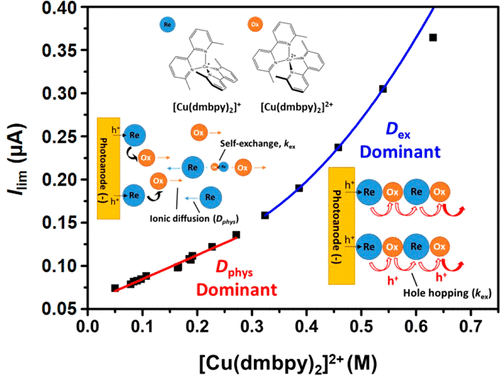当前位置:
X-MOL 学术
›
ACS Energy Lett.
›
论文详情
Our official English website, www.x-mol.net, welcomes your
feedback! (Note: you will need to create a separate account there.)
Real-Time Observation of the Diffusion Mechanism Progression from Liquid to Solid State of Transition Metal Complexes
ACS Energy Letters ( IF 19.3 ) Pub Date : 2020-01-27 , DOI: 10.1021/acsenergylett.9b02677 Tea-Yon Kim 1 , Yujue Wang 1 , Austin L. Raithel 1 , Thomas W. Hamann 1
ACS Energy Letters ( IF 19.3 ) Pub Date : 2020-01-27 , DOI: 10.1021/acsenergylett.9b02677 Tea-Yon Kim 1 , Yujue Wang 1 , Austin L. Raithel 1 , Thomas W. Hamann 1
Affiliation

|
Copper complexes have recently shown remarkable performance upon conversion from liquid-based to solid-state hole transport materials (HTMs) in mesoscopic solar cells; however, the diffusion mechanism is not clear. In this work, we apply an in situ solidification analysis of the charge diffusion and find that the dominant mechanism of [Cu(dmbpy)2]2+/+ (dmbpy = 6,6′-dimethyl-2,2′-bipyridine) changes from ionic to electronic diffusion. Through use of the modified Dahms–Luff equation, a fast self-exchange rate constant of hole-hopping in the HTM of 8.3 × 108 (±5 × 107) M–1 s–1 is calculated, which indicates a small reorganization energy of 0.47 eV. These results introduce a new methodology to analyze the transport mechanism of solids, reveal the mechanism of charge transport in molecular-based HTMs, and offer insight into ways to control the flow of charge in optoelectronic systems.
中文翻译:

过渡金属配合物从液态扩散到固态的扩散机理的实时观察
铜配合物最近在介观太阳能电池中从液态空穴传输材料转变为固态空穴传输材料(HTM)时表现出卓越的性能。但是,扩散机理尚不清楚。在这项工作中,我们应用了电荷扩散的原位凝固分析,发现[Cu(dmbpy)2 ] 2 + / +的主要机理(dmbpy = 6,6'-二甲基-2,2'-联吡啶)从离子扩散到电子扩散。通过使用修正的Dahms-Luff方程,HTM中的快速跳孔自交换速率常数为8.3×10 8(±5×10 7)M –1 s –1计算得出,表明重组能量很小,为0.47 eV。这些结果引入了一种新的方法来分析固体的传输机制,揭示了基于分子的HTM中电荷传输的机制,并提供了控制光电系统中电荷流的方法的见识。
更新日期:2020-01-29
中文翻译:

过渡金属配合物从液态扩散到固态的扩散机理的实时观察
铜配合物最近在介观太阳能电池中从液态空穴传输材料转变为固态空穴传输材料(HTM)时表现出卓越的性能。但是,扩散机理尚不清楚。在这项工作中,我们应用了电荷扩散的原位凝固分析,发现[Cu(dmbpy)2 ] 2 + / +的主要机理(dmbpy = 6,6'-二甲基-2,2'-联吡啶)从离子扩散到电子扩散。通过使用修正的Dahms-Luff方程,HTM中的快速跳孔自交换速率常数为8.3×10 8(±5×10 7)M –1 s –1计算得出,表明重组能量很小,为0.47 eV。这些结果引入了一种新的方法来分析固体的传输机制,揭示了基于分子的HTM中电荷传输的机制,并提供了控制光电系统中电荷流的方法的见识。











































 京公网安备 11010802027423号
京公网安备 11010802027423号